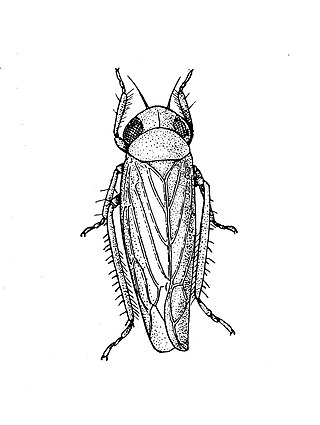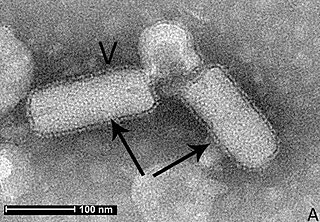
Geminiviridae is a family of plant viruses that encode their genetic information on a circular genome of single-stranded (ss) DNA. There are 522 species in this family, assigned to 15 genera. Diseases associated with this family include: bright yellow mosaic, yellow mosaic, yellow mottle, leaf curling, stunting, streaks, reduced yields. They have single-stranded circular DNA genomes encoding genes that diverge in both directions from a virion strand origin of replication. According to the Baltimore classification they are considered class II viruses. It is the largest known family of single stranded DNA viruses.

Leafhopper is the common name for any species from the family Cicadellidae. These minute insects, colloquially known as hoppers, are plant feeders that suck plant sap from grass, shrubs, or trees. Their hind legs are modified for jumping, and are covered with hairs that facilitate the spreading of a secretion over their bodies that acts as a water repellent and carrier of pheromones. They undergo a partial metamorphosis, and have various host associations, varying from very generalized to very specific. Some species have a cosmopolitan distribution, or occur throughout the temperate and tropical regions. Some are pests or vectors of plant viruses and phytoplasmas. The family is distributed all over the world, and constitutes the second-largest hemipteran family, with at least 20,000 described species.

Maize streak virus (MSV) is a virus primarily known for causing maize streak disease (MSD) in its major host, and which also infects over 80 wild and domesticated grasses. It is an insect-transmitted pathogen of maize in the genus Mastrevirus of the family Geminiviridae that is endemic in sub-Saharan Africa and neighbouring Indian Ocean island territories such as Madagascar, Mauritius and La Reunion. The A-strain of MSV (MSV-A) causes sporadic maize streak disease epidemics throughout the maize-growing regions of Africa. MSV was first described by the South African entomologist Claude Fuller who referred to it in a 1901 report as "mealie variegation".

Curly top is a viral disease that affects many crops. This disease causes plants to become smaller in size, have shriveled petals and leaves, and are twisted and pulled out of shape. They are often caused by curtoviruses, members of the virus family Geminiviridae. This disease is important in western United States, such as California, Utah, Washington, and Idaho.
Emmanuel Babatunde Alo is a Nigerian professor of applied biology, ecosystems, entomology and parasitology.

The beet leafhopper, also sometimes known as Neoaliturus tenellus, is a species of leafhopper which belongs to the family Cicadellidae in the order Hemiptera.

Beet curly top virus (BCTV) is a pathogenic plant virus of the family Geminiviridae, containing a single-stranded DNA. The family Geminiviridae consists of nine genera based on their host range, virus genome structure, and type of insect vector. BCTV is a Curtovirus affecting hundreds of plants. The only known vector is the beet leafhopper, which is native to the Western United States.

Maize dwarf mosaic virus (MDMV) is a pathogenic plant virus of the family Potyviridae. Depending on the corn plant’s growth stage, the virus can have severe implications to the corn plant’s development which can also result in economic consequences to the producer of the crop.

Urochloa panicoides is a fodder grass originating in Southern Africa.

The common brown leafhopper is one of the most common species of Australian leafhoppers with a very wide host range. It is an important vector of several viruses and phytoplasmas worldwide. In Australia, phytoplasmas vectored by O. orientalis cause a range of economically important diseases including legume little leaf, tomato big bud, lucerne witches broom, potato purple top wilt, Australian lucerne and the insect is a possible vector of Australian grapevine yellows. O. orientalis also transmits Tobacco yellow dwarf virus to beans, causing bean summer death disease and to tobacco, causing tobacco yellow dwarf disease.

Peregrinus maidis, commonly known as the corn planthopper, is a species of insect in the order Hemiptera and the family Delphacidae. It is widespread throughout most tropical and subtropical regions on earth, including southern North America, South America, Africa, Australia, Southeast Asia and China. P. maidis are a commercially important pest of maize and its relatives. In addition to physical plant damage, P. maidis is the vector for several species-specific maize viruses, including maize stripe virus, maize mosaic virus and the non-pathogenic Peregrinus maidis reovirus.

Macrostelini is a tribe in the Deltocephalinae subfamily of leafhoppers. Macrostelini contains 37 genera and over 300 species. The tribe has a cosmopolitan distribution. Some species in the genus Cicadulina are agricultural pests and transmit maize streak virus in Sub-saharan Africa.
Cicadulina is a leafhopper genus in the tribe Macrostelini.
Maize lethal necrosis disease is a viral disease affecting maize (corn) predominantly in East Africa, Southeast Asia and South America, which was recognised in 2010. It is caused by simultaneous infection with two viruses, MCMoV and any of several Potyviridae.

Cytorhabdovirus is a genus of viruses in the family Rhabdoviridae, order Mononegavirales. Plants serve as natural hosts.
Marafivirus is a genus of viruses in the order Tymovirales, in the family Tymoviridae. Plants serve as natural hosts. There are 11 species in this genus.
Mastrevirus is a genus of ssDNA viruses, in the family Geminiviridae. Mostly monocotyledonous plants serve as natural hosts. They are vectored by planthoppers. There are 45 species in this genus. Diseases associated with this genus include: maize streak virus: maize streak disease (MSD).

Corn stunt disease is a bacterial disease of corn and other grasses. Symptoms include stunted growth and leaves turning red. It is caused by the bacterium Spiroplasma kunkelii.
Southern rice black-streaked dwarf virus (SRBSDV) is a plant pathogenic virus of the family Sedoreoviridae, causing diseases in rice and maize, resulting in significant crop losses in Southern Asian countries. It is a member of the genus Fijivirus. It is not to be confused with the Rice black-streaked dwarf virus, as this virus does not contain the same insect vectors, and is an entirely separate virus. The sole transmitter of SRBSDV is Sogatella furcifera, aka the "white-backed planthopper" (WBPH). Close relative to the Laodelphax striatellus, which transmits the RBSD virus.











